Deputy Minister transition binder 2023: Climate change
Context
- The Intergovernmental Panel on Climate Change (IPCC) 6th Assessment Report reiterated that in order to limit warming to 1.5°C, while avoiding the worst impacts of the climate crisis, Governments across the globe need to significantly and urgently increase their ambition to reduce emissions and transition to a net-zero emissions economy.
- The need for increased climate ambition is not just a scientific imperative, but an economic one as well. As international momentum and support for decarbonization accelerates, countries recognize the need to secure a foothold in emerging clean technology supply chains, and ensure that they are positioned to thrive in a global net-zero emissions economy.
- Different countries adopted different measures to increase their climate ambition and support for decarbonization: the U.S. adopted the Inflation Reduction Act; the European Union approved the Battery Alliance and the Hydrogen Backbone Initiative.
- As climate change exacerbates disasters like wildfires, flooding, temperature spikes and droughts, Canada and nations around the world are recognizing the urgent need to adapt and build resilience, and are seeing natural environments lose biodiversity at a rapid pace.
- As climate impacts continue to intensify, Canada recognizes that more ambitious, strategic and collaborative action is required to adapt and build resilience to the impacts of climate change.
- Natural climate solutions (also known as nature-based solutions) can protect, sustainably manage, and restore ecosystems to contribute to climate change mitigation and deliver important co-benefits for society.
- In line with the need for strengthened climate ambition, Canada has:
- Enhanced its target to 40-45% below 2005 levels by 2030 and committed to achieve net-zero emissions by 2050
- Adopted a transparent framework to track Canada’s path to net-zero emission through the Canadian Net-Zero Emissions Accountability Act
- Released a National Adaptation Strategy and Federal Action Plan
Climate change is a global issue
The Working Group I contribution to IPCC 6th Assessment Report concluded it is unequivocal that warming of the climate is due to human influence.
The best estimate of human induced global warming is approximately 1.1°C above pre-industrial levels, closely matching the best estimate of observed warming over the same period. This warming will continue to persist for centuries to millennia, given the long lifetime of greenhouse gases in the atmosphere. Similarly, CO2-induced global warming will persist for centuries to millennia, given the long lifetime of CO2 in the atmosphere.
Best estimates of global temperature rise by late century, relative to pre-industrial, are 1.4 to 4.4°C global warming, depending on the emissions scenario. In the lowest emission scenario modelled, global temperature is projected to peak above 1.5°C and then decline due to deployment of measures to remove carbon dioxide from the atmosphere. This projection is part of the best estimates, but there are a range of projected values for each emission scenario.
IPCC Working Group III (Mitigation) concluded in their report released in 2022 that without a strengthening of policies beyond those implemented by the end of 2020, global warming of 3.2°C (2.2 to 3.5°C) is projected by 2100.
Canada’s climate is warming faster than the global average
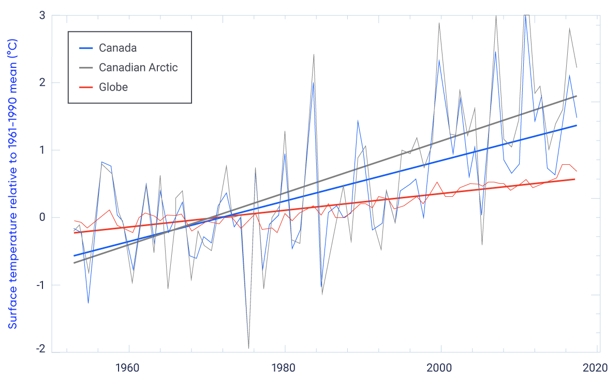
Text description
Chart showing the evolution of surface temperature differences relative to the mean from 1961 to 1990. Historical observations of annual mean surface temperature show that the rate of surface warming for Canada (slope of the blue line) is more than twice the rate of surface warming for the globe (slope of the red line). The rate of warming for the Canadian Arctic (slope of the grey line) is about three times the global rate.
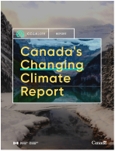
Canada’s Changing Climate Report, produced by ECCC in early 2019, explains how and why Canada’s climate has changed and what changes are projected for the future.
- Canada has warmed about 2X the global rate. Climate warming in Canada is not uniform – Northern Canada has warmed by about 3X global rate, and regions across Canada will experience different types of climate hazards.
- Canada has experienced changes in climate
- Extreme heat has increased, extreme cold has decreased
- Annual average precipitation has increased, with strong regional and seasonal variability
- Oceans surrounding Canada have warmed, become more acidic, and less oxygenated
- Snow cover and sea ice extent have decreased; glaciers have lost mass; and permafrost has thawed
- These changes are projected to intensify in the future, including some additional weather extremes resulting from a warmer climate.
Impacts of climate change are a concern across Canada
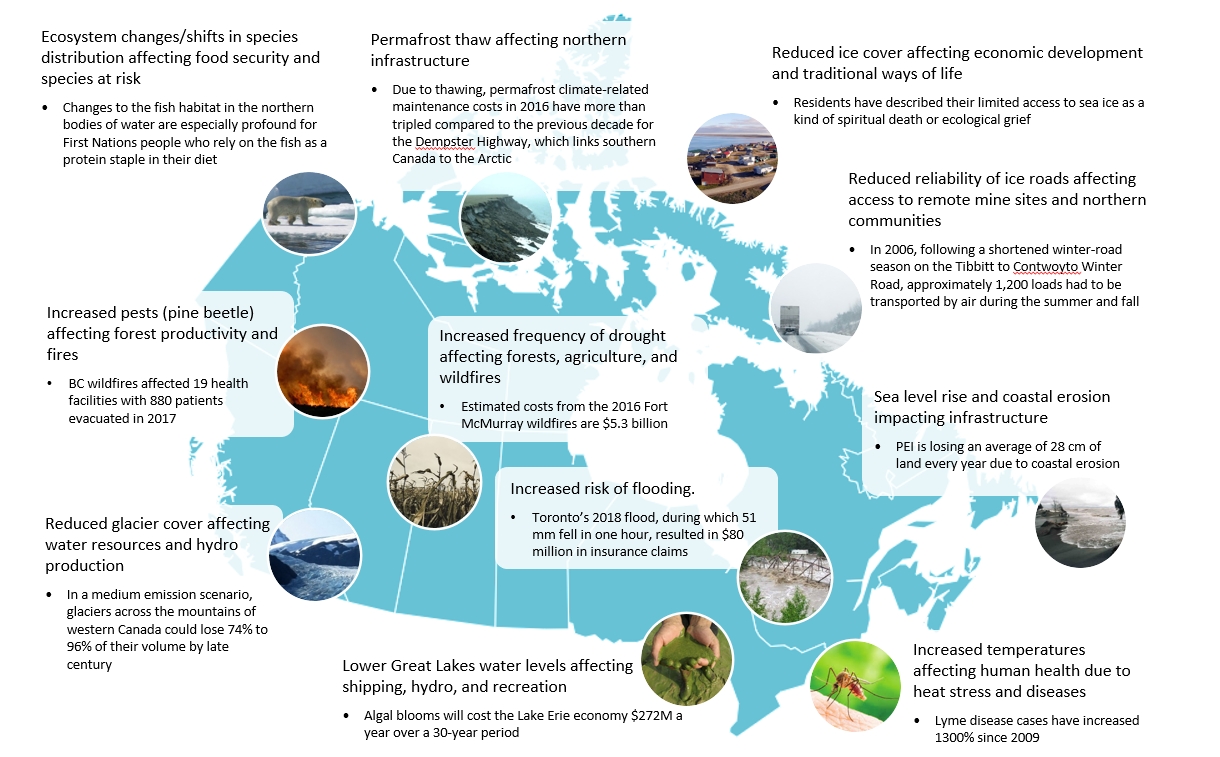
Text description
A map of Canada with 11 different climate change impacts across the country. These impacts are illustrated by various small circular images and include:
- Ecosystem changes/shifts in species distribution affecting food security and species at risk.
- Changes to the fish habitat in the northern bodies of water are especially profound for First Nations people who rely on the fish as a protein staple in their diet.
- Permafrost thaw affecting northern infrastructure.
- Due to thawing, permafrost climate-related maintenance costs in 2016 have more than tripled compared to the previous decade for the Dempster Highway, which links southern Canada to the Arctic
- Reduced ice cover affecting economic development and traditional ways of life.
- Residents have described their limited access to sea ice as a kind of spiritual death or ecological grief.
- Increased pests (pine beetle) affecting forest productivity and fires.
- BC wildfires affected 19 health facilities with 880 patients evacuated in 2017.
- Increased frequency of drought affecting forests, agriculture, and wildfires
- Estimated costs from the 2016 Fort McMurray wildfires are $5.3 billion.
- Reduced reliability of ice roads affecting access to remote mine sites and northern communities
- In 2006, following a shortened winter-road season on the Tibbitt to Contwoyto Winter Road, approximately 1,200 loads had to be transported by air during the summer and fall.
- Reduced glacier cover affecting water resources and hydro production.
- In a medium emission scenario, glaciers across the mountains of western Canada could lose 74% to 96% of their volume by late century.
- Increased risk of flooding.
- Toronto’s 2018 flood, during which 51 mm fell in one hour, resulted in $80 million in insurance claims.
- Sea level rise and coastal erosion impacting infrastructure.
- PEI is losing an average of 28 cm of land every year due to coastal erosion.
- Lower Great Lakes water levels affecting shipping, hydro, and recreation.
- Algal blooms will cost the Lake Erie economy $272M a year over a 30-year period.
- Increased temperatures affecting human health due to heat stress and diseases.
- Lyme disease cases have increased 1300% since 2009.
Canada’s international commitment
Paris Agreement
- Objective of limiting global warming to well below 2oC and pursue efforts to limit 1.5oC .
- Set national targets every 5 years, each more ambitious than the last, and enhance resilience and capacity to adapt.
- Transparency, accountability and stock-taking.
- Provide financial resources to support developing countries.
Canada’s commitment
- Cut GHG emissions to 40-45% below 2005 levels by 2030.
- Net-Zero Emissions by 2050.
- Work with provinces, territories, Indigenous Peoples, stakeholders, and international partners.
- Report regularly on emissions to UNFCCC.
- $5.3 Billion from 2021 to 2026 to support developing countries.
Canada’s 2021 enhanced Nationally Determined Contribution under the Paris Agreement
Overview of Canada’s efforts on climate change
Key achievements:
- Putting a price on carbon pollution
- Accelerated phase-out of coal-fired power by 2030
- Implementation of Clean Fuel Regulations
- Investing in public transit and making zero emission vehicles more affordable and accessible
- Released of proposed regulations for regulated ZEVs sales target
- Reducing emissions from the electricity sect and committed to achieve net-zero electricity grid
- Committed to comprehensive action, including legislation, to support sustainable jobs
- Reduced reliance on diesel in remote and Indigenous communities
- Developing a path forward on capping oil and gas emissions
- Supporting local climate action
The Government of Canada is committed to building a cleaner and more prosperous future for Canada – reducing Canada’s greenhouse gases and promoting clean technological solutions
- 2015: The Government of Canada committed to reduce greenhouse gas emissions by 30% below 2005 levels by 2030, under the Paris Agreement.
- 2016: Canada produced its first ever national climate plan, the Pan-Canadian Framework on Clean Growth and Climate Change (PCF).
- Developed with provinces and territories, and with input from Indigenous peoples, it included over 50 measures across all sectors.
- December 2020: Canada released its strengthened climate plan, A Healthy Environment and A Healthy Economy, renewing its federal climate ambition.
- The Strengthened Climate Plan (SCP) builds on the PCF, with 64 strengthened and new measures across five pillars, and $15 billion in new investments.
- April 2021: an additional $17.6 billion in investments for new green recovery measures to complement Canada’s SCP, through Budget 2021.
- June 2021: the Canadian Net-Zero Emissions Accountability Act (the Act) receives royal assent, setting in place the requirements for regular climate planning and target-setting, and establishes Net-Zero Advisory Body as a Governor-in-Council appointed body.
- July 2021: Canada formally submits its enhanced Nationally Determined Contribution to the Paris Agreement, by which it will reduce emissions by 40-45% below 2005 by 2030. Canada also submitted its first Adaptation Communication to the United Nations Framework Convention on Climate Change.
- November 2021: Canada signs the Global Methane Pledge to reduce economy-wide methane emissions by 30% by 2030 (from 2020 levels). Canada also becomes the first country to commit to reducing oil and gas methane emissions by 75% by 2030 (from 2012 levels).
- March 2022: The Government of Canada released the 2030 Emissions Reduction Plan, a critical milestone under the Act, with a sector-by-sector roadmap, with a suite of measures and strategies.
- The 2030 ERP includes $9.1B of new investments.
- April 2022: Budget 2022 made additional commitments to fight climate change and grow the economy.
- June 2022: Canada launches the Regional Energy and Resources Tables to empower the provinces and territories to decide their economic priorities and work collaboratively with the federal government to achieve them as part of a net-zero economy.
- September 2022: Canada submitted an updated Long Term Strategy to the UNFCCC outlining illustrative scenarios Canada could consider to meet its commitment to achieving net-zero emissions by 2050.
- November 2022: Canada released its first National Adaptation Strategy for final comment, setting ambitious goals, near-term objectives, and short-term targets for climate resilience across society.
- January 2023: The Net-Zero Advisory Body submitted its first annual report to the Minister of Environment and Climate Change under the Act, providing 25 recommendations to meet net-zero by 2050.
The Canadian Net-Zero Emissions Accountability Act
- Received Royal Assent in June 2021.
- Enshrines in legislation the Government’s commitment for Canada to achieve net zero emissions by 2050, and requires the Government to set national emissions reduction targets for 2030, 2035, 2040 and 2045.
- Requires the Government to table emissions reduction targets, emissions reduction plans, progress reports, and assessment reports in Parliament and release them publicly.
- Establishes an Advisory Body to provide advice to the Minister of Environment and Climate Change on ways to achieve net-zero by 2050.
- Calls for the Commissioner of the Environment and Sustainable Development to example and report on the Government’s implementation efforts at least once every five years.
- Requires an annual report regarding the federal administration management of financial risks and opportunities related to climate change (not yet in force).
2030 Emissions Reduction Plan
Written submissions received from provinces and territories, Indigenous Partners, the Net-Zero Advisory Body, stakeholders, and Canadians are reflected throughout the 2030 ERP.
- On March 29, 2022, the Government of Canada tabled the 2030 Emissions Reduction Plan (ERP) in Parliament and released the plan to Canadians. The 2030 ERP includes $9.1B of new investments – a key pillar of Budget 2022.
- The 2030 ERP is the Government of Canada’s next major step in taking action to address climate change and create good, sustainable jobs. It builds on federal climate actions taken to date, including those under preceding climate plans.
- The 2030 ERP is a sector-by-sector roadmap, with the measures needed for Canada to reach its emissions reduction targets of 40-45% below 2005 levels by 2030, and putting in place the building blocks for net-zero emissions by 2050.
- The 2030 ERP is an evergreen plan, and will continue to adapt as new opportunities arise and promising pathways to Canada’s 2030 target and net-zero emissions continue to emerge.
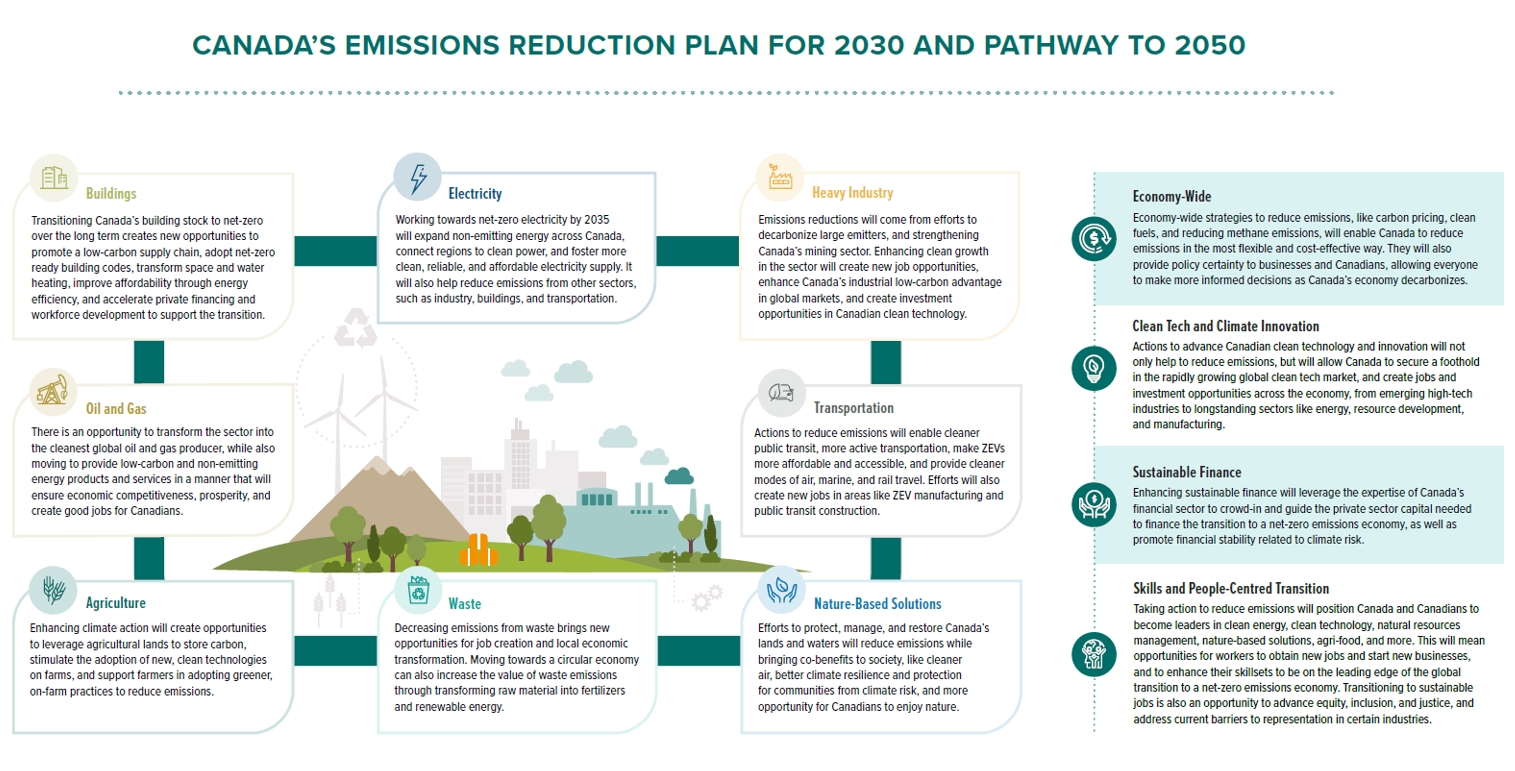
Text description
Canada’s Emissions Reduction Plan for 2030 and pathway to 2050
The 2030 ERP provides clear policy signals on how the government intends to achieve its 2030 decarbonization goal, including a focus on reductions in key sectors.
- Buildings
- Transitioning Canada's building stock to net zero over the long term creates new opportunities to promote a low-carbon supply chain, adopt net-zero energy ready building codes, transform space and water heating, improve affordability through energy efficiency, and accelerate private financing and workforce development to support the transition.
- Electricity
- Working towards net-zero electricity by 2035 will expand non-emitting energy across Canada, connects regions to clean power, and foster more clean, and affordable electricity supply. It will also help reduce emissions from other sectors, such as industry, buildings, and transportation.
- Heavy industry
- Emissions reductions will come from efforts to decarbonize large emitters and strengthening Canada's mining sector. Enhancing clean growth in the sector will create new job opportunities, enhance Canada's industrial low-carbon advantage in global markets, and create investment opportunities in Canadian clean technologies.
- Oil and Gas
- There is an opportunity to transform the sector into the cleanest global oil and gas producer, while also moving to provide low-carbon and non-emitting energy products and services in a manner that will ensure economic competitiveness, prosperity, and create good jobs for Canadians.
- Transportation
- Actions to reduce emissions will enable cleaner public transit, more active transportation, make ZEVs more affordable and accessible, and provide cleaner modes of air, marine and rail travel. Efforts will also create new jobs in areas like ZEV manufacturing and public transit construction.
- Agriculture
- Enhancing climate action will create opportunities to leverage agricultural lands to store carbon, stimulate the adoption of new, clean technologies on farms, and support farmers in adopting greener, on-farm practices to reduce emissions.
- Waste
- Decreasing emissions from waste brings new opportunities for job creation and local economic transformation. Moving towards a circular economy can also increase the value of waste emissions through transforming raw material into fertilizers and renewable energy.
- Nature-Based Solutions
- Efforts to protect, manage and restore Canada's lands and waters will reduce emissions while bringing co-benefits to society, like cleaner air, better climate resilience and protection for communities from climate risks, and more opportunities for Canadians to enjoy nature.
- Economy-wide
- Economy-wide strategies to reduce emissions, like carbon pricing, clean fuels, and reducing methane emission, will enable Canada to reduce emissions in the most flexible and cost-effective way. They will also provide policy certainty to businesses and Canadians, allowing everyone to make more informed decisions as Canada’s economy decarbonizes.
- Clean Tech and Climate Innovation
- Actions to advance Canadian clean technology and innovation will not only help to reduce emissions but will allow Canada to secure a foothold in the rapidity growing global clean tech market, and create jobs and investment opportunities across the economy, from emerging high-tech industries to long-standing sectors like energy, resource development and manufacturing.
- Sustainable Finance
- Enhancing sustainable finance will leverage the expertise of Canada's financial sector to crowd-in and guide the private sector capital needed to finance the transition to a net-zero emissions economy, as well as promote financial stability related to climate risk.
- Skills and People-Centred Transition
- Taking action to reduce emissions will position Canada and Canadians to become leaders in clean energy, clean technology, natural resources management, nature-based solutions, agri-food, and more. This will mean opportunities for workers to obtain new jobs and start new businesses, and to enhance their skillsets to be on the leading edge of the global transition to a net-zero emissions economy. Transitioning to sustainable jobs is also an opportunity to advance equity, inclusion, and justice, and address current barriers to representation in certain industries.
Key measures and strategies – 2030 ERP
The 2030 ERP invests $9.1 B in a suite of measures and strategies across all sectors of the economy. Key investments include:
- $150 million to develop a Canada Green Buildings Strategy to drive down emissions to net-zero by 2050
- $458.8 million to top-up the Canada Greener Homes Loan program
- $400 million in additional funding for ZEV charging stations, to achieve the target of adding 50,000 ZEV chargers to Canada’s network
- $1.7 billion to extend the Incentives for Zero-Emissions Vehicles Program to make it more affordable for Canadians to purchase ZEVs
- $194 million to expand the Industrial Energy Management System
- $780 million for the Nature Smart Climate Solutions Fund to deliver additional emissions reductions from nature-based climate solutions
- $470 million in the Agricultural Climate Solutions: On-Farm Climate Action Fund
- $330 million to triple funding for the Agricultural Clean Technology Program
- $100 million in transformative science for a sustainable agricultural sector and to support the sector’s role in the transition to a net-zero economy
- $2.2 billion to expand and renew the Low-Carbon Economy Fund
- $180 million for an Indigenous Climate Leadership Fund
- $25 million for Regional Strategic Initiatives to drive economic prosperity and the creation of sustainable jobs
- $600 million in the Smart Renewables and Electrification Pathways program to support renewable electricity and grid modernization
- $250 million to support predevelopment work for large clean electricity projects, in collaboration with provinces
Canada’s pathway to 2030
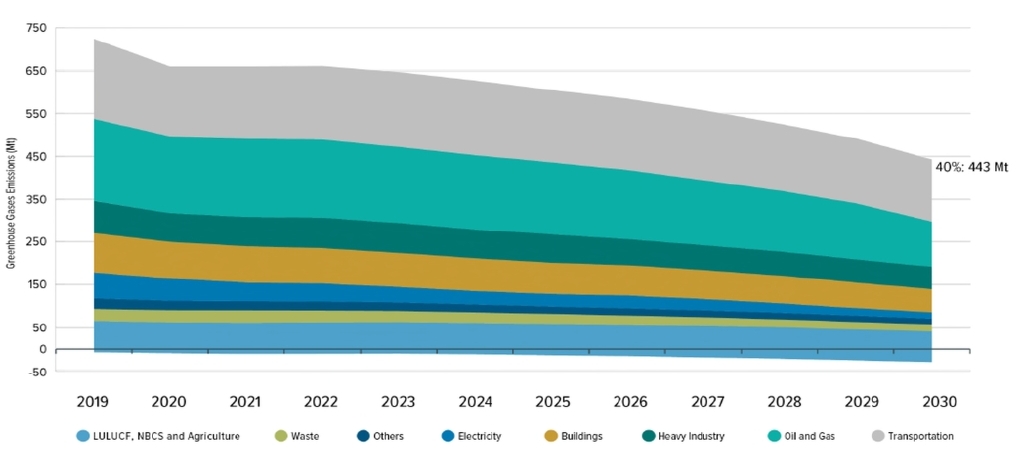
Text description
| Economic sector | 2019 | 2020 | 2021 | 2022 | 2023 | 2024 | 2025 | 2026 | 2027 | 2028 | 2029 | 2030 |
|---|---|---|---|---|---|---|---|---|---|---|---|---|
| LULUCF, NBCS and Agriculture (removal) | -8 | -10 | -11 | -11 | -10 | -12 | -14 | -16 | -19 | -22 | -26 | -30 |
| LULUCF, NBCS and Agriculture (emissions) | 73 | 72 | 73 | 73 | 73 | 73 | 73 | 73 | 73 | 72 | 72 | 71 |
| Waste | 28 | 28 | 28 | 27 | 26 | 24 | 23 | 22 | 20 | 19 | 18 | 16 |
| Others | 24 | 22 | 21 | 21 | 20 | 19 | 17 | 16 | 16 | 15 | 14 | 13 |
| Electricity | 61 | 52 | 43 | 42 | 36 | 31 | 29 | 30 | 26 | 22 | 18 | 14 |
| Buildings | 91 | 85 | 84 | 82 | 80 | 76 | 73 | 71 | 6 | 65 | 62 | 53 |
| Heavy industry | 77 | 69 | 71 | 73 | 72 | 70 | 66 | 61 | 58 | 56 | 55 | 52 |
| Oil and gas | 191 | 179 | 182 | 181 | 177 | 173 | 170 | 163 | 154 | 144 | 128 | 110 |
| Transportation | 186 | 162 | 168 | 171 | 174 | 174 | 168 | 165 | 162 | 156 | 151 | 143 |
| Total | 723 | 659 | 659 | 660 | 646 | 627 | 605 | 584 | 558 | 527 | 492 | 443 |
Canada’s interim objective will be 20% below 2005 levels by 2026. Existing and new measures profiled in the 2030 ERP position Canada to achieve the lower-bound of its 2030 target (40%). Broken down by sector, Canada’s pathway to 2030 is based on today’s understanding of the potential for each sector to reduce emissions by 2030.
Canada’s pathway to net-zero by 2050
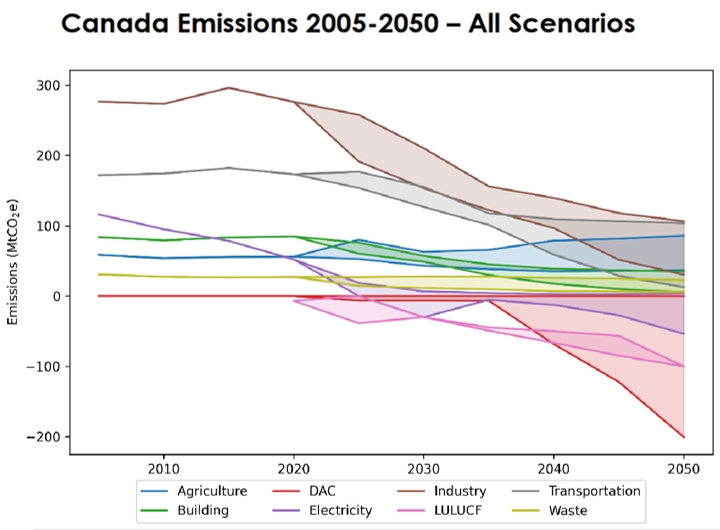
Source: Canada’s Long Term Strategy Submission to the UNFCCC (2022)
Text description
This figure is titled “Canada Emissions 2005-2020 – All Scenarios”. It presents the range of pathways each sector (agriculture, industry, buildings, electricity, transportation, waste, direct air capture, and LULUCF) takes to 2050 in all modelled scenarios, with shaded parts representing the bands in emissions pathways for each key sector. This figure demonstrates there are numerous pathways with a wide range of possibilities to achieving net-zero emissions in Canada. While these bands in emission pathways do not represent an exhaustive list of possible pathways, they are helpful in identifying general trends.
- The Canadian Net-Zero Emissions Accountability Act establishes the foundations and sets a legal imperative to achieve net-zero emissions by 2050.
- In October 2022, Canada submitted its long-term strategy to the UNFCCC, in accordance with Article, paragraph 19, of the Paris Agreement. The report explores approaches for Canada’s transition to net-zero emissions.
- Deep transformation of all sectors of the Canadian economy will be required, as well as protecting and enhancing our carbon sinks.
- Decarbonizing Canada’s economy offers many new opportunities in emerging clean technology industries.
- BloombergNEF tallied global investment in the low-carbon energy transition at US$755 billion in 2021, up 27% from $595 billion in 2020.
- By 2025, clean tech's contribution to Canada's GDP is expected to grow to $80 billion from $26 billion in 2016.
- There is no one-size-fits-all solution for achieving net-zero emissions. Different regions, sectors and groups will have their own pathways that reflect their unique circumstances.
Net-Zero Advisory Body
- On February 25, 2021, the Minister of Environment and Climate Change announced the launch of the Net-Zero Advisory Body. The Advisory Body is now formalized under the Canadian Net-Zero Emissions Accountability Act.
- This group of up to 15 experts has a mandate to provide independent advice to the Minister on pathways to achieve net-zero emissions by 2050. It will also engage broadly with experts, stakeholders, and Canadians.
- The NZAB’s first Annual Report to the Minister of Environment and Climate Change was released in January 2023.
- The report contains 25 recommendations across three lines of inquiry:
- Net-zero governance, e.g. “directing that all federal agencies, departments and Crown corporations publicly articulate their role in helping Canada achieve net-zero emissions”;
- Net-zero industrial policy, e.g. “urgently driving the development and implementation of a Canadian net-zero industrial policy to complement the 2030 ERP”; and,
- Net-zero energy systems, e.g. “facilitating the development of a vision for net-zero energy systems, akin to Canada’s nation-building project of the 21st century.”
- The NZAB’s recommendations take into account a range of factors, including economic costs and opportunities, environmental benefits, contributions to inclusivity and well-being, and technological readiness.
- ECCC is reviewing the recommendations and will be publishing a formal response by April 29, 2023, in accordance with the timelines established by the Act.
National Adaptation Strategy
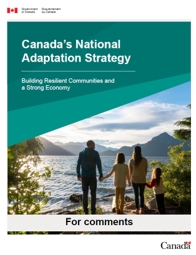
- Beyond mitigation measures, Canada’s approach to climate change is also to support Canadians in adapting to a changing climate.
- The National Adaptation Strategy (NAS) is a whole-of-society roadmap for a resilient Canada with priority actions to be advanced with partners through related action plans. Released in November 2022 for final comment, with the aim of ensuring that provincial, territorial and Indigenous perspectives are well captured.
Provides an overarching vision for resilience in Canada
All of us living in Canada, our communities, and the natural environment are resilient in the face of a changing climate. Our collective adaptation actions enhance our well-being and safety, promote justice, equity, and reconciliation with Indigenous Peoples, and secure a thriving natural environment and economy for future generations.
- Underpinned by guiding principles for fair, inclusive, and equitable adaptation
- Respect jurisdictions and uphold Indigenous rights
- Advance equity and environmental justice
- Take proactive, risk-based measures to reduce climate impacts before they occur
- Maximize benefits and avoid maladaptation
- Establishes transformational goals, objectives, and targets under five key systems: Health and Wellbeing, Nature and Biodiversity, Disaster Resilience, Economy and Workers, and Infrastructure.

National Adaptation Strategy: Implementation

Text description
A graph that shows how the three action plans to implement Canada’s National Adaptation Strategy are interconnected. They include the Government of Canada Adaptation Action Plan, the Indigenous Climate Leadership initiative, and the Federal-Provincial-Territorial Bilateral Action Plans.
Government of Canada Adaptation Action Plan (GOCAAP)
- The federal contribution to implement the National Adaptation Strategy, released November 24, 2022, is an inventory of Government of Canada measures that will contribute to National Adaptation Strategy goals, objectives, and targets.
- Includes new ($1.6 billion for new measures) and existing investments and programming ($4.9 billion spent since 2011).
- Clarifies and outlines the federal role in meeting adaptation goals and objectives and includes 68 actions across 22 federal departments and agencies
- To be updated at least every 5 years.
Indigenous Climate Leadership (ICL)
- Transitioning to a partnership model to advance self-determined climate actions (including adaptation) by First Nations, Inuit and Métis Nation.
- Continue to support Indigenous adaptation action while co-development of ICL is ongoing.
FPT Bilateral Action Plans
- Focused on alignment, coordination and implementation of shared federal, provincial and territorial priorities.
- To establish bilateral mechanisms to support PT priorities under the NAS.
Canada’s climate policy context
- Canada is a highly decentralized federation; environmental policy is an area of shared jurisdiction and provinces control the policy levers for many key emissions sources.
- Provinces and territories are important partners in climate action – working together is key to meeting Canada’s emissions targets.
- Every province and territory has unique geography, demographics, and economic realities; this is in turn results in different strategies for emission reductions.
- Canada works closely with provinces and territories to advance shared priorities that will further lower emissions on a regional, bilateral and multilateral basis, including through intergovernmental tables such as the Canadian Council of Ministers of the Environment (CCME).
- The Deputy Ministers Committee meets approximately 3-4 times a year and helps steer the Environmental Planning and Protection Committee (ADM level).
- The Minister of Environment and Climate Change is responsible for international climate change and inter-jurisdictional issues – GHGs are legislated at both federal and provincial levels.
Constructive engagement on the world stage
Canada contributes to the global agenda through:
- Engagement in key multilateral fora (i.e. MOCA, MEF G7, G20, UN, CBD, OECD, APEC, WTO) aimed at advancing the following:
- Ambitious and effective implementation of the Paris Agreement by all countries.
- Clean growth and the transition to a low carbon economy, including coal phase-out through co-lead of the Powering Past Coal Alliance and Just Energy Transition Partnerships.
- Committed to nature-positive international climate finance projects in line with the G7 2030 Nature Compact and the Leaders’ Pledge for Nature.
- Holistic climate action that unlocks synergies with respect to protecting nature and biodiversity and enhancing oceans resilience.
- Climate change science (via Canada’s Climate Change Science Plan) to ensure Canada leverages international climate science efforts and partnerships.
- International engagement on methane, with a focus on climate, air quality and economic objectives.
- Inclusive climate action that is gender responsive and takes into account the rights and perspectives of Indigenous peoples.
- Engagement and advocacy with key bilateral partners to complement Canada’s domestic and international climate goals, drive climate diplomacy and leverage these relationships to drive progress in multilateral fora.
- Support for climate action and capacity building in developing countries:
- Delivered $2.65 billion in international climate finance between 2016 and 2021.
- Doubled its international climate finance commitment at the G7 in June 2021, to $5.3 billion to be delivered between 2021-2026 – currently in the process of Year 3 investment planning.
- Board member of the Green Climate Fund (GCF) – and co-chair in 2020.
- Co-led with Germany the Climate Finance Delivery Plan and its Progress Report on contributors’ collective effort towards global US$ 100B climate finance goal.
- Allocated $2 million over the next four years to support methane mitigation projects.
Success requires effective partnerships
Provinces and territories
Canadian Council of Ministers of the Environment, bilateral engagement
Indigenous Peoples
Distinctions-based Senior Bilateral Tables with National Indigenous Organizations (First Nations, Inuit, Métis)
Other interested parties
Municipalities, non-governmental organizations, industry, small & medium-sized enterprises, scientific community
International partners
Multilateral and bilateral engagement
Federal partners
Over 20 departments and agencies
ECCC-led climate efforts
Climate policies, programs, and services
Climate Change Branch
- Collaborates with other federal departments, provinces and territories, Indigenous Peoples to develop and implement climate action and the Canadian Net-Zero Emission Accountability Act
- Publishes annual reports on progress and other reports to the UNFCCC
- Coordinates federal approach to adaptation
- Delivers programs and services
- Low Carbon Economy Fund
- Climate Action Incentive Fund
- Climate Action and Awareness Fund
- Canadian Center for Climate Services
- Leads on clean tech and liaison with the Clean Growth Hub
Robust climate science
Science and Technology Branch
- Provides authoritative and independent science and data underlying climate policy and services
- Leadership on IPCC, Arctic Council/Arctic Monitoring and Assessment Programme, World Climate Research Program Model Intercomparison Project
- Delivers key science policy and reports:
- Climate Science 2050
- Canada in a Changing Climate
- UNFCCC National Inventory Report (NIR)
- Faster & Further: Canada’s Methane Strategy
International climate negotiations and financing
International Affairs Branch
- Represents Canada at international for a and initiatives (e.g. United Nations Framework Convention on Climate Change, G7/G20 Environment Ministers, Powering Past Coal Alliance)
- Engages bilaterally with key international partners, including through free trade agreements, to support climate ambition
- Works with Global Affairs Canada to deliver international climate finance and support Canada’s membership at multilateral funds and banks
- Liaison with the Clean Growth Hub and promotes the adoption of Canadian clean technologies globally
Economic analysis
Strategic Policy Branch
- Delivers key reports:
- Annual GHG and air pollution emissions projections
- Promotes sustainable finance
- Leads medium-term planning and transition advice
- Develops modelled scenarios for 2050
Legislative & regulatory approaches to climate change
Environmental Protection Branch
- Current initiatives:
- Carbon pricing / GHG Offsets
- Exploring border carbon adjustments (with Fin Can)
- LDV and HDV Regulations
- Net-Zero Challenge
- Clean Fuel Regulations
- Methane regulations
- Phase out of coal-fired electricity
- Clean Electricity Regulations
- Hydrofluorocarbons regulations
- Oil and Gas Emissions Cap
- Small Spark Ignition Regulations
- Guidance on best in class oil and gas projects
Next steps
Key legislative and priority deliverables
- Response to NZAB advice (2023)
- ERP Progress Report (2023)
- Establish 2035 Emissions Reduction Target (2024)
- Release final National Adaptation Strategy (2023)
Regulations and programs
- ZEV sales mandate (2023)
- Clean Electricity Regulation (2023)
- Oil and gas methane emissions (2023)
- Cap on oil and gas emissions (regulatory proposal in 2023)
- Landfill methane emissions (2024)
Events and reports
- COP28 in the United Arab Emirates (2023)
- CS2050: Canada’s Climate
- Change Science and Knowledge Plan (2023)
- Communicate next NDC (2025)
